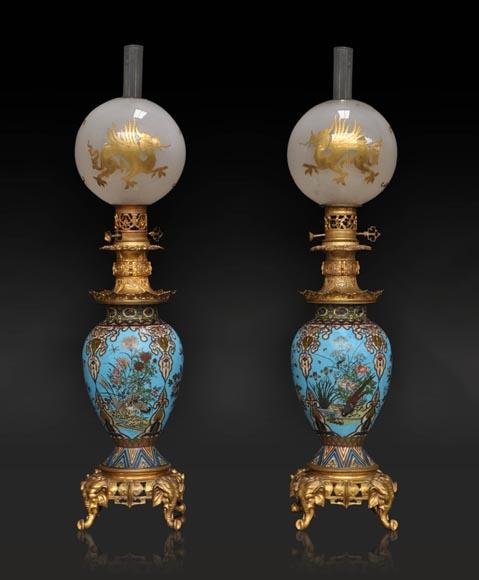Reproduction and Influence of Eastern Aesthetics in European Culture: Historical and Artistic Exploration of Chinoiserie

The Western understanding of the East is closely intertwined with European cultural history, influenced not only by Eastern objects but also by fictionalized and idealized conceptions of the East. Cultural elements from China and Japan, such as lacquerware, porcelain, and naturalistic garden design, permeated Europe over several centuries, becoming part of the European collective consciousness and symbols of the “Orient.”
With the colonial activities of Portugal and Spain, as well as the rise of trading institutions like the East India Company, Eastern goods such as lacquerware and porcelain began to enter the European market. These items were admired by Westerners for their unique luster, colors, and decorations, but their original cultural meanings were often lost in translation, being reinterpreted with the imagined characteristics of the “Orient” by the West.
When the Chinoiserie craze occurred and peaked in Europe during the 17th and 18th centuries, Eastern aesthetics transcended the simple perspectives of possession and control, with positive notions of the East coexisting with negative ones. This oscillation between attraction and neglect, misunderstanding and inspiration, is seen as a key process in the integration of Chinese and Japanese elements into European culture. The “otherness” represented by Chinoiserie became a contrasting element that spurred a higher level of self-awareness in European aesthetics, playing a significant role in the development of identity in European countries such as Britain.
Ferdinand Barbédienne, a pair of lamps decorated with Chinese Jingdezhen porcelain (cloisonné)
In this exchange, Eastern objects were often dismantled, reassembled, or modified to meet the tastes and demands of the European market. European craftsmen began to imitate or merge Chinese and Japanese design elements, creating new art forms. The rise of Orientalism was both a yearning for the East and a way of understanding and reproducing it. For instance, in the 1880s, French-made lamps incorporated Chinese Jingdezhen porcelain (known as cloisonné) vases. The cloisonné work was incredibly intricate, featuring an astonishing level of delicacy, forming the main body of each lamp. One lamp showcased a grebe in a lakeside scene, while another depicted cranes; the reverse side of each lamp was adorned with various bouquets, with small butterflies and birds perched on the branches. The colors used were extremely rich and vivid. The gilded bronze decorations by Parisian bronzesmith Ferdinand Barbedienne were exceptional, a technique derived from the gilding aesthetics of the Baroque era. This represents a classic collision of Eastern and Western aesthetics in decorative art. Additionally, the gilded mounts served to physically protect the porcelain. Each lamp’s base consisted of four finely carved elephant heads, supported by their trunks, and the glass lampshades featured dragon motifs. These lamps exemplify a practice popular at the end of the 19th century, stemming from the immense love for the East at the time, which involved repurposing genuine Chinese elements in European-designed objects to decorate the most luxurious interiors.

ChuCui Palace “Kirin in Clouds” Brooch
A classic piece from ChuCui Palace that combines Eastern symbols with Western craftsmanship is the “Kirin in Clouds” brooch. This piece exemplifies the Chinoiserie style, showcasing the “beauty of disorder” derived from Eastern aesthetics. It depicts a kirin soaring through the clouds, with distinct layers and flowing lines, adorned with lotus flowers, creating a poetic realm of nature and mystery. The abstract Chinese cloud patterns, with their delicate and elegant curves, contrast sharply with the majestic kirin, displaying the dynamic beauty unique to Chinoiserie.
This brooch employs the asymmetrical composition derived from Eastern aesthetics in Chinoiserie, while seeking visual balance and harmony within the asymmetry. In terms of color, soft pink and gold complement each other with a natural transition, and the indigo accents add color tension, making the kirin appear both magnificent and vibrant. The entire piece not only conveys the mystique of the mythical creature but also endows it with a sense of realistic beauty.
“Kirin in Clouds” is not a mere imitation of Eastern aesthetics but delves deeply into its cultural connotations. The addition of lotus flowers evokes the Chinese poetic imagery of “step by step, a lotus blooms,” endowing the piece with unique poetic and aesthetic layers. It showcases the Eastern philosophy of reverence for nature, in contrast with Western rational aesthetics.

A ceramic painting produced in Delft, Netherlands, and drawn by Joan Nieuhof
In the Amsterdam Museum in the Netherlands, there is a ceramic painting produced in Delft in 1680, drawn by Joan Nieuhof, a Dutch traveler. Nieuhof is renowned for his extensive travels, particularly his 2,400-kilometer journey from Guangzhou to Beijing between 1655 and 1657, which established him as an authoritative writer on Chinese themes in the West at the time. He documented this journey in his book “An Embassy from the East India Company of the United Provinces to the Grand Tartar Cham, Emperor of China.” As part of the diplomatic mission, Nieuhof was tasked with drawing accurate representations of any cities, palaces, temples, rivers, and other notable buildings they encountered. These images later became important references for European artists and craftsmen during the Chinoiserie craze.
In this ceramic artwork, the artist is cautious about using Western techniques of shading and chiaroscuro, showing reluctance to apply these methods to paintings with Chinese themes. The composition is rich and layered, with a complex yet orderly arrangement of figures, buildings, and natural elements, creating a vibrant and dynamic scene. The author evidently organized and collaged his observations. The artwork not only celebrates Eastern culture but also reflects a cosmopolitan attitude.
Overall, Chinoiserie is not merely a product of the collision between Eastern and Western cultures, but also a process of understanding, misunderstanding, and recreating Eastern culture by Europe. This style goes beyond simple imitation and possession, blending aesthetic elements from different cultures to form a unique artistic expression. The rise of Chinoiserie in the 17th and 18th centuries reflects not only Europe’s fascination and longing for Eastern culture but also the European effort to engage in self-reflection and cultural identity through art and design. This cross-cultural exchange and integration enriched European art and material culture, providing valuable historical experience and insights for our understanding of multiculturalism today. In the context of modern globalization, re-examining the history and aesthetic value of Chinoiserie can help us better understand and respect the interaction and symbiosis between different cultures.





